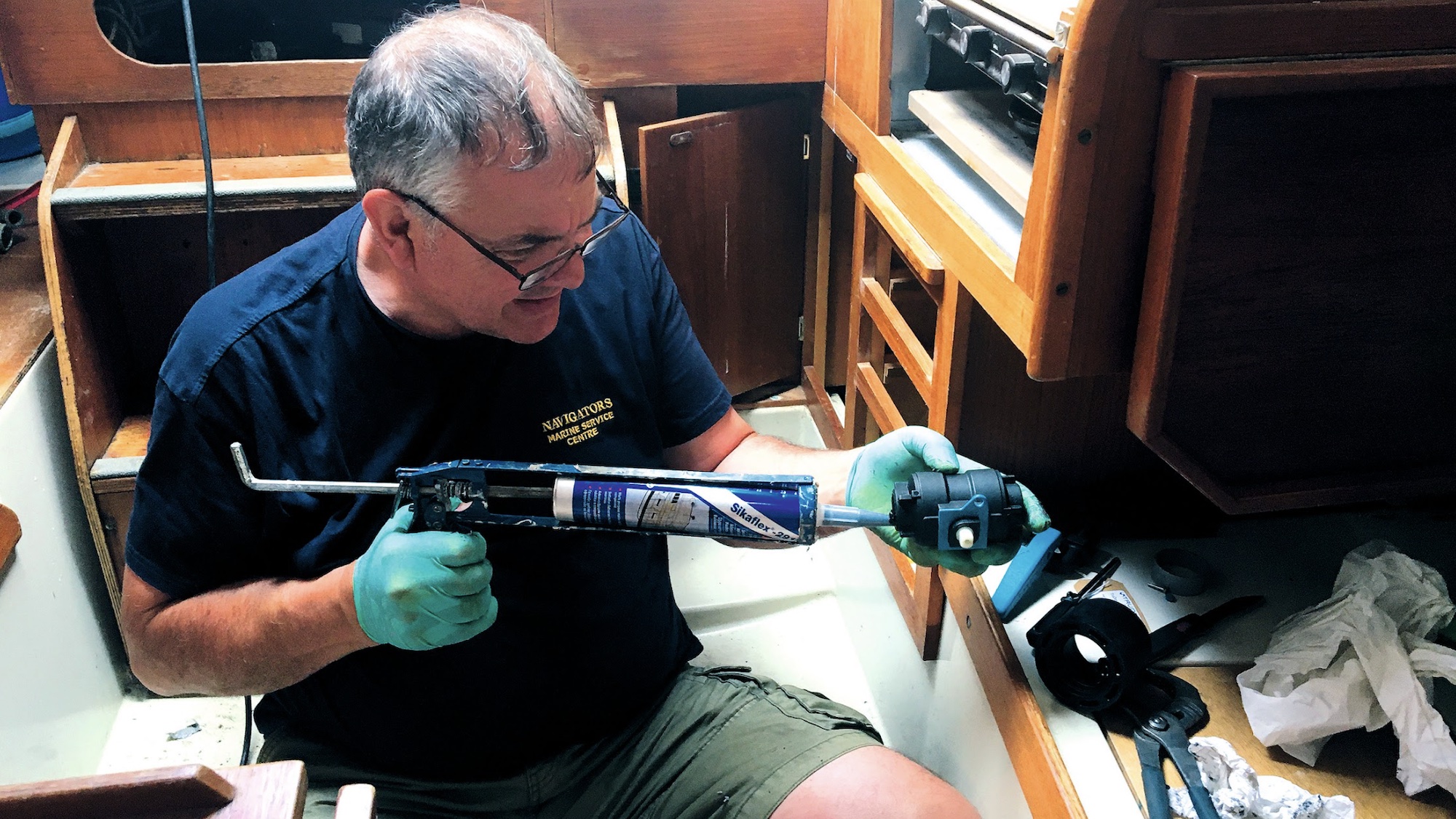With the help of ACM Marine, Ali Wood goes about securing mast cable on the Maxi 84 PBO project boat
Securing mast cable on our Maxi 84
When we acquired Maximus, our Maxi 84 Project Boat in the summer of 2021, the electrics were in a poor state.
The cables were UV damaged, brittle and cracked, and the deck glands were corroded and leaking.
“If they’re like that down here, then it’s going to be worse at the top of the mast,” said our electrician Adam McMenemy of ACM Marine.
The 44-year-old mast was going to have to come down for a full rewire, but at least that meant we could also replace the nav lights with modern LED equivalents.

The old wiring had been run through the centre of the mast and encased in protective foam
When Adam and his colleague, Ciaran, got to work they were surprised to find the old cables for the tri-light, aerial and wind indicator ran down the inside of the Seldén mast, rather than either side of the conduit on the aft edge.
Presumably to stop the slapping noise, they’d also been encased in foam which was chafed and burnt.
And the wire was domestic, rather than marine.
Marine grade wire
“Marine grade cable has tin-coated copper wire, making it more resistant to corrosion,” explained Adam. “The wire strands are thinner, making them more flexible, and the plastic, or ‘jacket’ around them is also a lot bendier, which is important given how much a boat flexes.”
Adam and Ciaran lubricated the cables and carefully ran them into the outer edge of the conduit, taking care to keep them straight.
With two of these running together along a very tight space, it was important they didn’t get twisted.
Meanwhile, the sail cars, used to hoist the mainsail, would run down the middle of the conduit.

The top of Maximus’s mast. The cables need to be fed either side of these cutaway grooves
We were pleased with Maximus’s rewire, but a year later, after a storm raged through Cobb’s Quay Marina in Poole, one of the cables worked free from the conduit. Adam returned to take a look.
We gently hoisted the mainsail, so the cars pushed the cable back in, then Adam tightened the cable at the base of the mast and secured it with a cable-tie.
This held for a while, but on sailing back from the Isle of Wight one afternoon, the cable came loose again at the top and got caught around a spreader.
Continues below…
Boat rewire tips: How we completely rewired the PBO Project Boat
Our marine surveyor Ben Sutcliffe-Davies switched on the instruments of our Maxi 84, Maximus, and I held my breath. Nothing.…
Upgrading electronics on the PBO Project Boat
Upgrading electronics on Maximus seemed like a huge leap in the first weeks of ownership. We were still discovering new…
What battery capacity? Working out your boat’s power requirements
In order to work out your boat’s battery capacity you need to know how much power you’re going to draw,…
Fitting new seacocks and skin fittings on the PBO Project Boat
Maximus, our PBO Project Boat, had four seacock fittings that need changing – three ball valves in the forepeak (1…
It was frustrating; not only was I worried we’d damage the cables, but it also meant we couldn’t get our smart new sails up.
We limped back with a fully reefed mainsail on a very calm day!
I spoke to various trades, and while some suggested the cables should have been run through the mast, Adam was clear this wasn’t the solution. “You can’t have them slapping against the halyards,” he warned. “They’ll chafe and rattle all over the place.”
He explained that requirements vary between masts but most Seldén ones have a conduit to split cables.

The bottom of Maximus’s mast. The halyards run down the centre of the mast and the cables should be in the grooves
This was a sealed mast; were we to try and fit a conduit inside, we’d need to drill from the outside in order to secure it, potentially weakening the structure.
This could take a day or longer and still not work.
He sent me a PDF from Seldén which confirmed that retrofitted cables for this type of mast should indeed be fed through grooves either side of a U-shaped conduit.
I took another look at our mast, and saw that the conduit at the bottom was corroded and bits had broken off.
Maybe it was also like that higher up.

How closed cell foam can be used to keep cables in place. Credit: Maggie Nelson
Adam brainstormed with rigger Barry Lock at Emsworth, who’d kindly inspected our rig the summer before.
Barry came up with a suggestion: why don’t we insert electrical trunking into the mast?
Adam and Ciaron drove down from Chichester armed with various trunking profiles from their local hardware superstore.
We managed to lasso the cable free from the spreader and again hoisted the mainsail slowly, pushing the cable back into its correct position.
Next, Adam tugged the loose cable tight at the bottom, pushed it back through the Scanstrut deck gland and then cable-tied it. So far, so good.
Putting it to the test
Adam next removed the sail gate and tried a few different pieces of trunking. The 25mm one fitted the best and came in 2m lengths.
The ridge on the ‘open’ side was a little too deep so we had to trim it until it was a good, but not too tight, fit in the mast groove.
He then used household detergent to lubricate the trunking before sliding it up through the sail gate gap.
With the cables either side of the trunking, we tried hoisting the sail a metre or so. Success!
We kept pushing the conduit into the mast and the higher up we got, the harder it was to keep pushing the 2m sections in.

The cable worked free of the mast again during our sail back from the Isle of Wight
It required some serious grunt and prodding with sail battens and pieces of wood.
Had the mast been down I imagine the process would have been easier. Adam got the trunking as high as the spreaders, at which point the mast track tapers.
Ciaran then went up the mast with some bits of packing foam (those wiggly things you get in parcels) – a recommendation from Seldén’s website.
At intervals he pushed the foam into the outside of the grooves holding the cables (see diagram, above left).
Hopefully now they’d stay in place.
The moment of truth had now arrived. With the cables secure behind the trunking would we be able to hoist the sail? The answer was yes.
To my delight the sail cars went up very quickly and smoothly. And I’m delighted to say the cables have remained firmly in situ ever since.
Well done Barry, Adam and Ciaran.
Securing mast cable: step by step

We hoisted the sail gently to get the cable back into the correct groove.

Electrical trunking is inexpensive and comes in 2m lengths.

Adam tightens the cables at the bottom to ensure they stay put.

Ali trims the edge of the trunking so it’ll fit snugly in the mast groove.

Adam starts inserting the trunking up through the sail gate hole.

Success! The plastic trunking installed inside the mast.
Enjoyed reading Securing mast cable on our Maxi 84?
A subscription to Practical Boat Owner magazine costs around 40% less than the cover price.
Print and digital editions are available through Magazines Direct – where you can also find the latest deals.
PBO is packed with information to help you get the most from boat ownership – whether sail or power.
-
-
-
- Take your DIY skills to the next level with trusted advice on boat maintenance and repairs
- Impartial in-depth gear reviews
- Practical cruising tips for making the most of your time afloat
-
-








